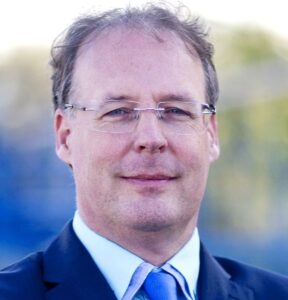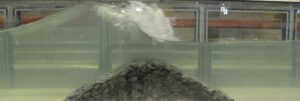
Due to climate change, addressing sea level rise has become one of the most pressing global challenges of our time. Coastal structures like breakwaters and dykes play an important role in protecting the surrounding areas, but they are also at risk from rising sea levels. With decades of experience in coastal engineering, Professor Marcel van Gent is working to develop measures that deal with this challenge. Some of his latest research is published in the Journal of Coastal and Hydraulic Structures through TU Delft OPEN Publishing.
Coastal structures and waves
As a hydraulic engineer, Marcel van Gent has spent more than 30 years focused on coastal engineering and structures. After completing a PhD at TU Delft in 1995, he went to work for Deltares, a world-renowned water and subsurface research institute based in Delft. Four years ago he returned to the university as a part-time Professor of Coastal Structures at the Faculty of Civil Engineering and Geosciences. Much of his work is based on laboratory testing performed at Deltares, where van Gent is also senior specialist on Coastal Structure and Waves and science board member. His research interests lie in the impacts of climate change and sea level rise on different types of coastal structures.
Specifically, van Gent aims to come up with measures to deal with the sea level rise that affects existing structures, for example breakwaters and dykes. He explains that sea level rise normally increases the wave loading on existing structures such as these, but it is often not ideal to change the structures themselves. “One of the measures that is relevant is to construct a so-called low-crested structure in front of a dyke or in front of a breakwater,” he says. “This more or less dissipates wave energy before it reaches the structure or at least a large part of the wave energy.”
Wave flume tests

A submerged low-crested structure is below water during severe storm conditions and can consist of stones, concrete units, or different materials. Last year, together with colleagues and a TU Delft student, van Gent published a paper on wave transmission, meaning how much energy goes over a low-crested structure, but that research did not include an accompanying dyke or breakwater behind the low-crested structure. He explains that there are some physical processes in which the two structures are relevant, one of them being that the water level between the low-crested structure and the dyke or the breakwater increases a bit. He wanted to know how much the water level would increase between the two structures and whether it affects the wave transmission over the low-crested structure.
After conducting tests in a wave flume with different types of structures, van Gent found that increasing water levels between the two structures can be quite significant. It depends on several parameters like the wave steepness and the crest height of the low-crested structure. “But at the end of the day, it was possible to summarise those tests in empirical equations that you can use to actually predict the increase in the water level,” he says. This research is published in the Journal of Coastal and Hydraulic Structures. Van Gent also selected the journal for an upcoming conference he is co-chairing. Coastlab24, the 9th Conference on Physical Modelling in Coastal Engineering will be hosted at TU Delft from 13-16 May, 2024. As part of a thematic series related to the conference, they will publish a selection of conference papers in the journal featuring themes like climate change (adaptation), multifunctional and nature-inclusive designs, port development, and wave or tidal energy.
Open reaches more people
Open access journals like this one have certainly changed the way people disseminate their research. Of course, it is possible to ask authors to share their paper, which is how things were done back when van Gent finished his PhD. But things have changed over the years with a significant increase in the numbers of journals and papers being produced. “Open access makes it much easier to share the results of research, so in terms of facilitating the users, open access is very important,” says van Gent. “You reach many more people if the papers are open access.” And every researcher wants their research to be used by others, notes van Gent. “I think in my case with this topic it’s even more relevant because I’ve come up with some design guidelines that people can actually use in their design,” he says. “So even people who are not that familiar with doing research themselves might be interested in the results.”
Scientifically sound measures
His interest in coastal structures combined with developments in climate change and sea level rise motivate van Gent and his research. “I want to focus on coming up with scientifically sound measures so you can adapt these structures if the sea level rise is more than expected when they were originally designed. That is the case for many structures, because sea level rise was not an issue some time ago or it was just a fixed value that was assumed. The values that we expect now are larger, so the measures that need to be taken are also more serious. We need design methods and measures to modify the structures so that once significant sea level rise occurs, we know how to adapt to it.”
